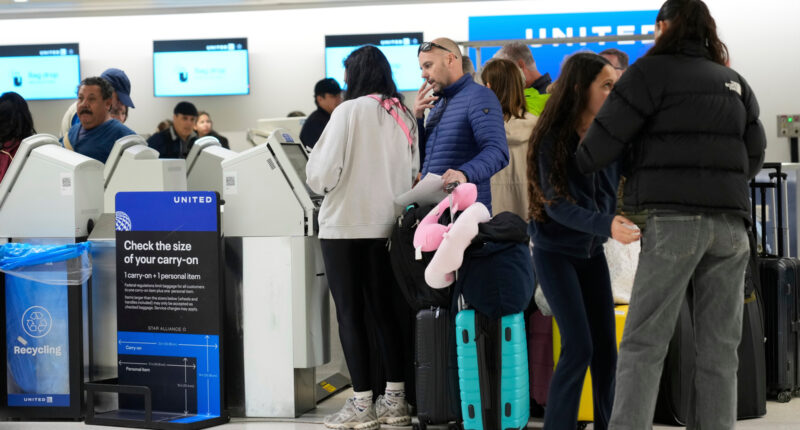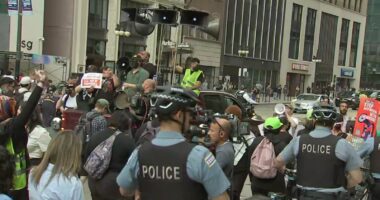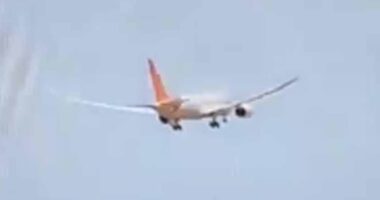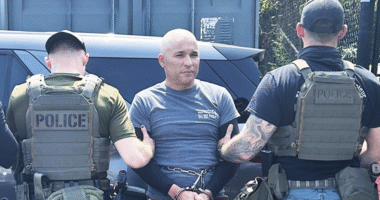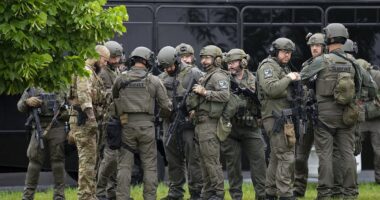The recent issue of chronic delays and flight cancellations at the largest airport in New Jersey has brought attention to the lack of air traffic controllers and the outdated equipment they are using. The current administration, led by President Donald Trump, is aiming to replace this aging equipment.
To address the immediate concerns at Newark airport, the Federal Aviation Administration is working on a temporary solution. This involves repairing technical issues and reducing the number of flights to better manage air traffic amidst a shortage of controllers. Officials have scheduled meetings with all airlines operating out of Newark, beginning on Wednesday, to discuss this plan.
Even prior to these recent challenges, the aviation industry has been under scrutiny following a tragic midair collision between a commercial jet and a U.S. Army helicopter over Washington, D.C., in January. This incident, along with a series of other accidents and incidents, has raised concerns. As investigations into these events continue, the U.S. Department of Transportation is striving to address the ongoing issues related to the shortage of air traffic controllers and reliance on outdated equipment. A Senate hearing scheduled for Wednesday morning will specifically examine the FAA’s actions and initiatives.

Travelers check into their flights at Newark Liberty International Airport in Newark, N.J., Monday, May 5, 2025.
AP Photo/Seth Wenig
What happened in Newark?
Twice in the past two-and-a-half weeks, the radar and communications systems that air traffic controllers in Philadelphia who direct planes in and out of Newark rely on failed for a short time. That happened because the lines that carry the radar signal down from another FAA facility in New York failed, and the backup system didn’t work immediately.
So the controllers were left unable to see or talk to the planes around Newark Liberty International Airport for as long as 90 seconds on April 28 and May 9. The lines – some of which were old copper wires – failed a third time on Sunday, but that time the backup system worked and the radar stayed online.
But the first one of those stressful situations prompted five to seven controllers to take a 45-day trauma leave, and that worsened the existing staff shortage at the Philadelphia control facility, prompting the FAA to limit the number of flights in Newark each day.
The FAA currently has 22 fully certified air traffic controllers and five supervisors assigned to Newark in the Philadelphia facility, but the agency wants to have 38 controllers there. Another 21 controllers are in training there, and 10 of them are certified on at least part of the area.
What has been done in Newark?
The FAA quickly limited the number of flights in Newark to between 24 and 28 arrivals and the same number of departures every hour to make sure the remaining controllers could handle them safely. At times when controller staffing is especially lean, like Monday, the FAA is limiting traffic even further. Before the problems, 38 or 39 flights would take off and land every hour in Newark.
The meetings FAA officials are having with all the airlines starting Wednesday are focused on a plan that continues limiting takeoffs and landings to no more than 28 apiece an hour until at least mid-June. By then, a runway construction project should be wrapped up, and the controllers who took trauma leave would be scheduled to return. After that, the FAA has said it might be able to bump up the limit to 34 arrivals and 34 departures an hour.
Meanwhile, the number of flights a day must be cut because the airport can’t handle everyone on the schedule. That’s why Newark has generally led the nation in cancellations and delays in recent weeks. After the FAA meets with the airlines, it will give them a couple of weeks to submit information in writing, so it won’t issue a decision before May 28.
The FAA has been able to install new fiber optic lines at Newark airport and the two other major airports in the New York area – Kennedy International and LaGuardia – but those are still being tested and won’t come online until the end of the month. Officials were able to update some computer software last week that kept the radar from going offline a third time on Sunday when the primary line failed yet again.
Longer-term, the FAA is also planning to build a new radar system in Philadelphia, so that controllers there won’t have to rely on the signal piped down from New York anymore. But that might not be done for months, although officials are working with contractors to speed up that project.
Why not hire more controllers?
The FAA has been working for a long time to hire more air traffic controllers to replace retiring workers and handle the growing air traffic. But it can be hard to find good candidates for the stressful positions, and it takes years to train controllers to do the job.
Transportation Secretary Sean Duffy has made several moves to try to hire more controllers. The FAA is trying to shorten the time it takes between when someone applies to the air traffic controller academy in Oklahoma City and when they start, and the agency is also trying to improve the graduation rate there by offering more support to the students. The candidates with the highest scores on the entrance exam are also getting top priority.
The FAA is also offering bonuses to experienced controllers if they opt not to retire early and continue working to help ease the shortage.
More high-tech simulators are also being used at airports across the country, including Newark, to train air traffic controllers. The FAA said Tuesday that controllers tend to complete training more quickly when they use one of the 111 simulators it has.
“These new simulators give air traffic control trainees a high-tech space to learn, develop and practice their skills,” said acting FAA Administrator Chris Rocheleau.
What about the outdated equipment?
The Transportation Department plans to ask Congress for billions and billions of dollars to pay for an overhaul of the air traffic control system nationwide to replace the 618 radars, install 4,600 new high-speed connections and upgrade all the computers controllers use. The exact price tag hasn’t been determined.
Duffy blames former President Joe Biden’s administration for failing to upgrade the air traffic control system, but Congress first recognized the system was struggling to keep up with the growing number of flights as far back as the 1990s, so the problems go back decades – long before the Biden or first Trump administrations. Biden’s former Transportation Secretary Pete Buttigieg has defended their efforts to upgrade some of the technology and expand air traffic controller hiring.
Some of the decades-old computer equipment that controllers rely on was on display at last week’s news conference about the plan, which has drawn broad support from more than 50 groups across the industry. Duffy has used an assortment of colorful metaphors to emphasize how old the equipment is, saying the gear looks like it came off the set of the movie “Apollo 13” and comparing it to a 1967 Volkswagen Beetle.
Copyright © 2025 by The Associated Press. All Rights Reserved.
